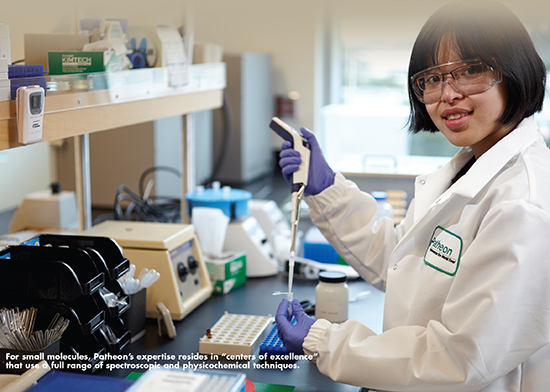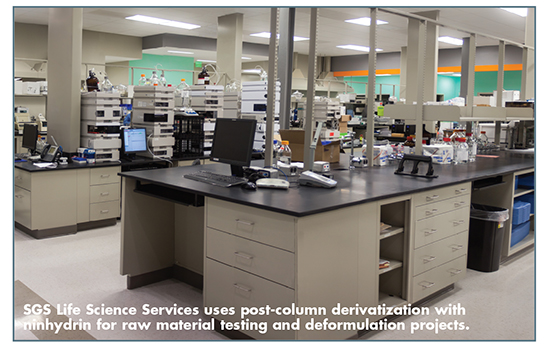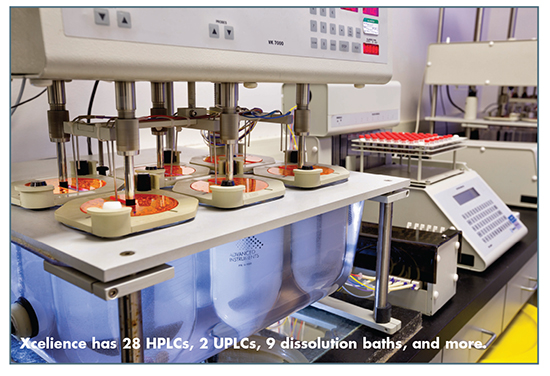Issue:January/February 2016
SPECIAL FEATURE - Analytical Testing: Using More Sophisticated Tools to Support Small & Large Molecule Projects
As pharmaceutical companies increasingly demand more integrated solutions from fewer vendors, contractors are adding capabilities. One area where this is becoming evident is in analytical testing, where contract labs are procuring more analytical tools to handle increasingly complex multinational clinical trials on an accelerated basis, according to Capstone Partners.1
“Analytical testing plays an important role in all phases of pharmaceutical development and is the most outsourced among all CMC activities,” says Chris Gregory, General Manager of Catalent’s Morrisville, NC facility. Gregory says new trends in the pharmaceutical and biotech industry are driving innovation and creative outsourcing solutions.
First, the pharma outsourcing model has changed in recent years. Traditionally, big pharma outsourced late-phase and routine programs to analytical testing labs and retained early-phase method development projects and problem-solving activities in house. Recently however, big pharma is transitioning bench scientists from laboratory work to direct management of outsourcing activities. Additionally, companies are outsourcing their analytical work much earlier in the product development phases. Occasionally, contract analytical labs are engaged when dealing with some of the most challenging projects so scientists from both labs can work through the problems together.
The second trend, according to Wei Pan, PhD, Director Strategy and Analytical CMC at Catalent, is a result of a recent FDA guidance, “Abuse-Deterrent Opioids – Evaluation and Labeling.” The FDA now expects development programs that study abuse-deterrent technologies to include data from three categories: laboratory-based in vitro manipulation and extraction studies (Category 1); pharmacokinetic studies (Category 2); and clinical abuse potential studies (Category 3). Category 1 testing is exclusively laboratory-based and proper design of studies is essential. Results from Category 1 studies identify the methods of manipulation that yield the greatest release of opioid. This is critical because it influences the design of both Category 2 and Category 3 clinical studies.
“For companies without experience designing and conducting Category 1 abuse-deterrent studies, outsourcing these studies to analytical labs with expertise in this area will save money and time, and ensures that proper data is generated in support of pharmacokinetic and abuse potential clinical studies,” says Dr. Pan.
For large molecules, the areas of analytical testing to support CMC activities that are on the rise include surfactant and process impurity testing, glycan analysis, and high-resolution analysis of macromolecules. There has also been an industry shift from slab gel to capillary analysis for electroseparations, and a call for more robust effector function assays for monoclonal antibodies and kinetic binding assays (both surface plasmon resonance and biolayer interferometry). These changes are mainly driven by increased regulatory expectations as advances in analytical resolution/sensitivity and capacity increase, and more becomes known about the increased complexity of biological molecules (e.g. fusion proteins, conjugated, bispecifics).
“As the industry has matured, there are greater expectations for analytical details to fully understand the molecule, especially in the ever-advancing field of biosimilarity, and the requirements that are needed to prove equivalence,” says Rekha Patel, Large Molecule Analytical Chemistry at Catalent.
Drug Development & Delivery recently spoke with leading analytical testing providers to find out what services they offer and what equipment they use to handle both small and large molecules for their pharma clients.
Catalent – Finding Solutions for Development Challenges
Catalent provides a full range of analytical services to pharmaceutical and biotechnology companies to support both drug development and manufacturing. As drug product pipelines fill with molecules that are becoming more complex and challenging, the instrumentation and technologies needed to support clients and satisfy regulators have to evolve. Catalent has invested in increasingly sophisticated instrumentation to assist its clients in solving the most challenging analytical problems for large and small molecules.

In addition to basic analytical services, Catalent offers more complex analysis such as mass spectroscopy (including Orbitrap, Triple Quad Mass Spectrometry, QTOF Mass Spectrometry, and Ion Trap capabilities), bioassays, kinetic binding assays (Octet and Biacore), and characterization tools such as analytical ultracentrifugation (AUC), circular dichroism, Fourier Transform Infrared (FTIR) Spectroscopy, and MicroFluid Imaging (MFI). Catalent can undertake complex and challenging chromatographic assays to support peptide map analysis including glycan and excipient analysis. Assays can be transferred from clients for optimization to Catalent’s large molecule analytical service, or developed from scratch to be used for a multitude of purposes such as characterization, stability testing, release testing, in-process testing, and all levels of phase-appropriate validations.
For companies developing small molecules, poor solubility/bioavailability is a challenge. Catalent has developed the OptiForm® Solution Suite to accelerate development and reduce risks at the early screening phase. This analytical screening solution follows a three-step approach: 1) application of high throughput screening tools to collect preformulation data to assess the molecule’s characteristics; 2) evaluation of multiple bioavailability enhancement technologies in parallel (e.g., particle size reduction, polymorph or salt form selection, hot melt extrusion, lipid-based softgel capsules); and 3) delivery of the optimal formulation. This integrated service helps the molecule progress to animal pharmacokinetic studies and Phase I clinical trials.
The Catalent analytical scientist team recently helped a client solve a challenging problem at a critical time. A softgel capsule manufacturer observed a new impurity peak that was out of specification in all batches during process validation. Laboratory investigation performed in the customer’s QC lab suggested that the peak was real and needed to be fully identified and characterized. With stock build-up and product launch in jeopardy, the customer reached out to Catalent for help. Utilizing LC-MS, the team quickly identified the unknown peak as two co-eluting phthalate peaks. Phthalates are common plasticizers used to make plastics more flexible and hard to break. The Catalent scientists worked with the softgel manufacturer to gain knowledge of the production line, and eventually traced the phthalate’s source to a piece of PVC tubing used in the production line. With the information Catalent provided, the customer made the necessary change and moved forward with its product launch plan.
“This analytical and investigative mindset is typical of Catalent scientists who are in the business of finding solutions for challenges in drug development, for both small and large molecule formulations,” says Chris Gregory, General Manager of Catalent’s Morrisville, NC, facility.
Patheon – Focused on Three Areas of Analytical Capability
Most technical decisions made during development and manufacturing are based on analytical testing results. Analytical development laboratories don’t get to select the compounds they work on, so the key to project success is having an analytical team with strong scientific capabilities, good instrumentation, deep and broad problem-solving experience, and a large network of experts to provide a specialized focus when needed.
There are three critical areas where analytical capability plays a crucial role in long-term project success. First, characterization of the active ingredient and a thorough understanding of its interaction in the expected formulation environment are vital to developing good formulations. For small molecules, Patheon’s expertise resides in “centers of excellence” that use a full range of spectroscopic and physicochemical techniques. The real value comes in not just rote application of instrumental techniques, but also integrating the information into a comprehensive assessment of formulation approaches for low-solubility compounds.

“Our formulation agnostic approach combines analytical characterization and parallel screening of formulation options, such as lipid emulsions in soft or hard-gelatin capsules, solid dispersions (spray-drying), and particle size reduction to rapidly identify the most promising outcomes,” says William E. Weiser, PhD, Executive Director, Global Head of Analytical Sciences, Patheon.
In addition, Patheon’s Quadrant2™ technology is a hybrid computational and empirical tool that identifies appropriate formulation technologies, defines valid excipient choices, and produces acceptable drug-loading expectations for the company’s formulation processes supported by Patheon.
The second critical area for long-term analytical success is the development and validation of robust methods for determining assay and related substances. This activity is accomplished through a combination of chemical knowledge and method development context. Knowledge development is based on the continuum of information developed for the API, formulation, manufacturing process, and stability assessment stages, and even during troubleshooting activities.
“Our OneSource™ program can streamline development by sharing compound-specific knowledge, developing testing methods in parallel, sharing method development responsibilities, and facilitating seamless hand-offs throughout a project,” explains Dr. Weiser. “Method development context is an understanding of the starting point for an incoming method and how the method is going to be used. We use a phase-sensitive risk assessment for all methods that quantitatively ranks the risk of the method. We can then judge the value of any needed method development relative to the stage of the project. Further optimization is accomplished in a structured fashion using automated systems to map out the method design space. This approach is aligned with recently issued guidelines from the FDA (“Analytical Procedures and Methods Validation for Drugs and Biologics – Guidance for Industry,” FDA, July 2015).”
The third critical area is developing and executing methods with long-term robustness and reliability. In early stages of projects, method development may be done quickly with the goal of just getting something to work. An example of a poorly designed method is an extended gradient HPLC method (40 minutes) used to test dissolution or content uniformity samples. While this approach may work for a Phase 1 program, in later stages, the impact may be dramatic. For example, during process validation or QbD studies, the sample load can quickly become onerous (thousands of samples equating to weeks of run time). With emerging emphasis on continuous manufacturing, the ability to generate samples may completely outstrip analytical capacity for an inappropriate method.
To demonstrate the value of an integrated analytical/formulation approach to problem solving, consider this example of a poorly soluble, small molecule NCE formulated in a soft-gelatin capsule. Although developmental formulations were demonstrated to be stable, a small change in the capsule fill concentration was required for clinical needs. According to Dr. Weiser, formulated product that used API from a different supplier generated undesirable precipitates in the filling matrix. A combination of XRPD, DSC, hot-stage microscopy, and particle size analysis was used to characterize the API, while IR was used to verify the non-API nature of the precipitates. In this case, the analytical testing and knowledge of the formulation fill matrix was required to advance the product and generate an acceptable formulation for clinical trials. “Blind application of even highly advanced analytical techniques does not solve formulation challenges; integration of project and product knowledge in parallel with analytical science is the key to success,” says Dr. Weiser.
SGS Life Science Services – Using New Methods to Address Client Needs
Outsourcing of analytical testing to the cGMP contract research organization gives pharmaceutical companies peace of mind that laboratory testing integrity is in the hands of experts. Although the majority of analytical tests for well-known APIs and excipients are performed following USP and other pharmacopoeial procedures, there is high demand for highly sensitive, specific, and high throughput techniques for analytical testing of newly discovered potential drugs in both API and final formulations.
SGS Life Science Services deploys established and conservative analytical procedures, as well as the latest technology and methodologies. “For example, instead of monitoring impurities of amino acid raw materials (ninhydrin positive substances) by thin layer chromatography (TLC), modern post-column derivatization with further detection in visible range by HPLC is being used at our lab,” explains Natalia Belikova, PhD, Analytical Services Director, SGS Life Science Services.

Post-column derivatization with ninhydrin has been used successfully by SGS for raw material testing, as well as for deformulation projects, where individual components of a formulated product needed to be separated, identified, and quantified. “For example, we have had requests to analyze Histidine, Arginine, Lysine, and other amino acids (both in base and hydrochloride forms) for ninhydrinpositive substances tests (EP 2.2.56, Method 1),” explains Dr. Belikova. “We have also executed a study for a patent prosecution group for Arginine Monohydrochloride.”
Xcelience – Ensuring the Final Dosage has the Right Properties
Testing capabilities that can help move a client’s product through the development process begin at the preformulation stage. By building a good base of data with the API, problems that might be encountered later during the developmental process can be more easily identified and overcome. This includes using XRD to determine the polymorphic structure, running pH solubility profiles, and particle size/distribution analysis. This data will help ensure that when the API is made at a larger scale, the physical and chemical properties of the API do not change. During manufacture, the testing can include determining moisture content to ensure there is good content uniformity, and monitoring tablet hardness that can change the dissolution profile. Additional testing could include instrumentation such as Accupyc and GeoPyc, which will provide true density of the ribbons produced during roller compaction. A ring shear tester can be used to measure the potential of granulation to stick to dosator or tablet punches. The analysis on the finished dosage form will include dissolution, assay by HPLC or UPLC, moisture content, and polymorph testing.
“The goal is to ensure that throughout the manufacturing process, appropriate properties are monitored to establish that the final dosage form has the desired properties,” says Paul Skultety, PhD, Vice President, Pharmaceutical Development Services, Xcelience.

A trend in the pharmaceutical business is to build quality into the product. With this in mind, the analytical method development process is also being adapted. Techniques include not only generating appropriate data, but also developing equipment that can generate the data faster. Examples include UPLCs, applying automation to disintegration apparatus to determine disintegration times for each tablet or capsule automatically, and developing better or more sensitive analytical techniques to provide the requisite data in a timely manner.
The biggest challenge associated with analytical testing is to determine what properties of the dosage form need to be monitored and what specifications should be put in place to maintain the desired properties. Once these are determined, the analytical tests need to be developed with enough sensitivity to adequately monitor these properties. This can include ensuring such things as the correct polymorphic structure is maintained, and particularly for controlled-release products, that the right dissolution profile is maintained.
Developing the right dissolution test method for poorly soluble, high-dose compounds also can be a challenge. The method must show that the API will be completely released in the desired time frame. Often, clients are using API in capsule for Phase I clinical trials. For low-dose compounds, it can be a challenge to develop a technique for an assay or determine moisture content for a capsule shell containing less than one milligram of API, says Dr. Skultety.
Another challenge is with combination products, which can sometimes have a larger number of degradation compounds that must be separated. Two examples come to Dr. Skultety’s mind. The first was a problem that arose with a capsule product. The capsule shell was cross linking and the product would not dissolve. After lengthy evaluation, it was determined that the problem was due to the presence of an aldehyde in part per million quantities.
“The product was saved by limiting the specification for the amount of aldehyde,” he says. “Once this was established, the stability of the product was fine.”
The second example was the use of XRD to monitor the appropriate polymorph. The product was a wet-granulated tablet. It was determined that the amount of water added and the wet massing time could change the API to a different polymorph or cause the API to become amorphous. A technique was developed to measure the quantity of different polymorphs in the granulation. This allowed for a granulation process to be developed that ensured the finished dosage form had the correct polymorph.
To view this issue and all back issues online, please visit www.drug-dev.com.
Reference
1. Capstone Partners, Pharmaceutical Outsourcing Report, Q3 2015, http://www.capstonellc.com/sites/default/files/Capstone_Pharma_Outsourcing_Report_Q3_2015.pdf, accessed Dec. 14, 2015.
Total Page Views: 2977

















